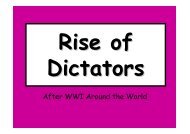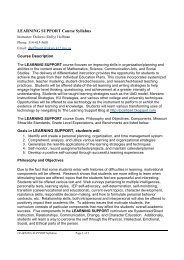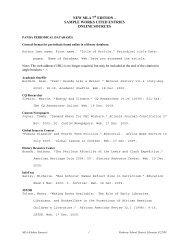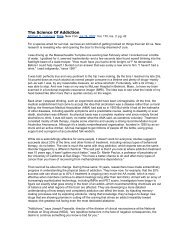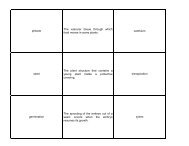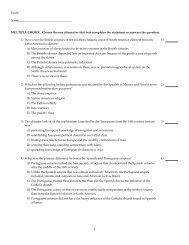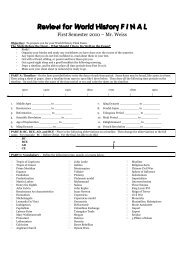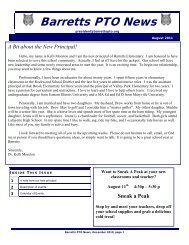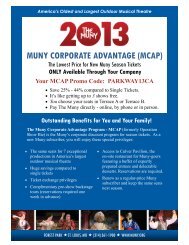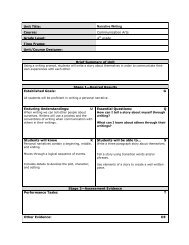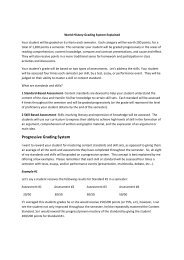The Canterbury Tales Intro
The Canterbury Tales Intro
The Canterbury Tales Intro
Create successful ePaper yourself
Turn your PDF publications into a flip-book with our unique Google optimized e-Paper software.
ENG LIT – Biggs<br />
<strong>Canterbury</strong> <strong>Tales</strong> <strong>Intro</strong>.<br />
<strong>The</strong> <strong>Canterbury</strong> <strong>Tales</strong><br />
By Geoffrey Chaucer<br />
“Questions press upon him [Chaucer]; he asks them, but…leaves them unsolved, uncramped<br />
by the solution of the moment, and thus fresh for the generations that come after him.”<br />
- Virginia Woolf<br />
THE MIDDLE AGES (1066 – 1509)<br />
1066 – Battle of Hastings; Norman Conquest –<br />
Marks the end of the Old English Period and the beginning of <strong>The</strong> Medieval (or Middle<br />
English) Period.<br />
During this time period the crusades began, <strong>The</strong> Hundred Years War took place, the Black<br />
Death struck, the Peasants’ Revolt occurred, and Caxton introduced the printing press.<br />
1509 – Henry VIII ascends the throne –<br />
Marks the end of the Medieval (Middle English) Period and the beginning of the Renaissance.<br />
<strong>The</strong> Middle Ages was a time of great change sparked by violence. Read excerpts of <strong>The</strong> Daily<br />
Life in Chaucer’s England by Jeffrey L. Singman and Will McLean for more information on<br />
this time period. Understanding the time period helps understand Chaucer and his work.<br />
WHY CHAUCER? (b. estimated in 1342 – d. Oct. 25, 1400)<br />
Geoffrey Chaucer is the dominant literary figure to emerge from the Medieval Age.<br />
His <strong>Canterbury</strong> <strong>Tales</strong> ranks as one of the greatest works of all time. It might surprise you to<br />
learn that a good bit of Chaucer’s material is taken from other writings, but before you write<br />
off Chaucer as a plagiarist, look at his era. <strong>The</strong>re were no copyright laws (Shakespeare, too,<br />
was quite a “borrower” of other plots), and the originality of the story line was not much<br />
valued. Instead, the teller who could make the story come alive was celebrated and treasured.<br />
(Think about the importance of story-telling from Beowulf. That spirit continued into the<br />
Middle Ages, and Chaucer was that kind of story-teller.<br />
Comparisons of his works with other treatments of similar plots reveal his genius for<br />
developing characters and re-creating dialogue. His handling of detail, as you will see in the<br />
Prologue, is more revealing than paragraphs of description by a less-talented writer. <strong>The</strong><br />
variety in the collection of stories shows that he was a master of many forms. <strong>The</strong> sheer<br />
brilliance of his story-telling is enough to ensure his reputation, but there is more.<br />
<strong>The</strong>re are thirty travelers, including Chaucer himself, in the <strong>Canterbury</strong> <strong>Tales</strong>. Each<br />
was to tell four stories, two on the way to the Shrine of Thomas Becket and two on the return<br />
journey. Chaucer only completed twenty-four stories, but his multi-leveled complex array of<br />
frame and tales has never been duplicated in English literature. It’s too bad that Chaucer died<br />
before it was even half-finished.
ENG LIT – Biggs<br />
<strong>Canterbury</strong> <strong>Tales</strong> <strong>Intro</strong>.<br />
ABOUT THE CANTERBURY TALES:<br />
<strong>The</strong>y are written in rhyming iambic pentameter couplets<br />
(known as heroic couplets)<br />
Example (from Alexander Pope’s <strong>The</strong> Rape of the Lock):<br />
<strong>The</strong> hungry judges soon the sentence sign,<br />
And wretches hang that jurymen may dine.<br />
Chaucer intended his <strong>Canterbury</strong> <strong>Tales</strong> to be an encyclopedia work (including a multitude of<br />
literary forms)—what the Middle Age writers loved to do. He sought to draw together all<br />
forms of literature prevalent at the time.<br />
His <strong>Canterbury</strong> <strong>Tales</strong> include:<br />
1. exempla (an exemplum is an anecdote that exemplifies a moral, right way of living; it<br />
was used by preachers to prove their points; the Pardoner’s Tale is an exemplum)<br />
2. knightly romance (story of knights and their deeds; main elements include adventure,<br />
love, and magic; the Wife of Bath’s Tale is a knightly romance)<br />
3. French fabliaux (the fabliau is a bawdy tale that involves bourgeois or lower class<br />
people in an outrageous, often obscene plot; the Miller’s Tale is a fabliau)<br />
4. sermons and beast fables<br />
Although allegories were a more common style for communicating morals, Chaucer<br />
preferred a more indirect, sophisticated approach through broad humor and satire.<br />
Chaucer used satire as a weapon to expose the injustice and human hypocrisy he observed.<br />
To gather the diverse forms into a coherent narrative, Chaucer built a world in <strong>The</strong><br />
<strong>Canterbury</strong> <strong>Tales</strong> that is unparalleled in literature. He unified his work in two ways: he used<br />
the journey motif, and he made the stories and their tellers interact and comment on other<br />
stories and tellers. This “frame” for his tales is as lively and interesting as the tales<br />
themselves. Other writers had used frames, but Chaucer is again far above the rest of the<br />
crowd. He employed the device of a pilgrimage, a journey undertaken to some religious<br />
shrine (quite familiar to his audience), to bring together a sampling of medieval society. He<br />
included representatives from the basic classes of his world: the upper class world of the court<br />
is seen in the knight and his squire; the religious world, with its saints and sinners, is amply<br />
revealed in the pious Parson, the dainty Prioress, the nefarious Summoner, the greedy<br />
Pardoner, the unholy Monk, and the calculating Friar. He includes the middle classes with<br />
characters like the Wife of Bath (a weaver) and the Franklin, and the lower classes are figures<br />
like the uncouth Miller and the Reeve. In fact, Chaucer’s cross section of the population of<br />
14 th century England is missing only the very highest and the very lowest ranks, the nobility<br />
and the serfs.
ENG LIT – Biggs<br />
<strong>Canterbury</strong> <strong>Tales</strong> <strong>Intro</strong>.<br />
TOPICS OF FOCUS FOR READING & DISCUSSION<br />
In addition to the various forms of literature, the rhyme scheme, and the satirical language,<br />
consider the following:<br />
1. Look for examples of irony as it points out the disparity between what appears to be<br />
and what really is, especially in the Prologue.<br />
2. In what ways do the tales match the character of the teller?<br />
3. How do the stories comment on medieval society?



